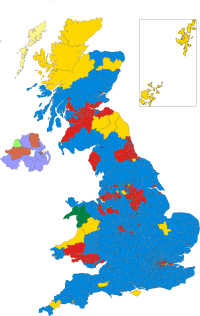| |||||||||||||||||||||||||||||||||||||||||||||||||||||||
All 650 seats in the House of Commons 326 seats needed for a majority | |||||||||||||||||||||||||||||||||||||||||||||||||||||||
|---|---|---|---|---|---|---|---|---|---|---|---|---|---|---|---|---|---|---|---|---|---|---|---|---|---|---|---|---|---|---|---|---|---|---|---|---|---|---|---|---|---|---|---|---|---|---|---|---|---|---|---|---|---|---|---|
| Opinion polls | |||||||||||||||||||||||||||||||||||||||||||||||||||||||
| Turnout | 72.7% ( | ||||||||||||||||||||||||||||||||||||||||||||||||||||||
| |||||||||||||||||||||||||||||||||||||||||||||||||||||||
 Colours denote the winning party—as shown in § Results | |||||||||||||||||||||||||||||||||||||||||||||||||||||||
 Composition of the House of Commons after the election | |||||||||||||||||||||||||||||||||||||||||||||||||||||||
| |||||||||||||||||||||||||||||||||||||||||||||||||||||||
The 1983 United Kingdom general election was held on Thursday 9 June 1983. It gave the Conservative Party under the leadership of Margaret Thatcher the most decisive election victory since that of the Labour Party in 1945, with a majority of 144 seats and the first of two consecutive landslide victories.[1]
Thatcher's first term as Prime Minister had not been an easy time.[2] Unemployment increased during the first three years of her premiership and the economy went through a recession. However, the British victory in the Falklands War led to a recovery of her personal popularity, and economic growth had begun to resume.
By the time Thatcher called the election in May 1983, opinion polls pointed to a Conservative victory, with most national newspapers backing the re-election of the Conservative government. The resulting win earned the Conservatives their biggest parliamentary majority of the post-war era, and their second-biggest majority as a majority government, behind only the 1924 general election (they earned even more seats in the 1931 general election, but were part of the National Government).[3]
The Labour Party had been led by Michael Foot since the resignation of former Prime Minister James Callaghan as Leader of the Labour Party in 1980, and its new policies were considered more left-wing than before.[3][4] Several moderate Labour MPs had defected from the party to form the Social Democratic Party (SDP), which then formed the SDP–Liberal Alliance with the existing Liberal Party. Labour was further harmed by its promise to withdraw from the European Economic Community, which alienated Pro-European groups.
The opposition vote split almost evenly between the Alliance and Labour. With its worst electoral performance since 1931, the Labour vote fell by over 3,000,000 votes from 1979, accounting for both a national swing of almost 4% towards the Conservatives and their larger parliamentary majority of 144 seats, even though the Conservatives' total vote fell by almost 700,000. This was the last general election until 2015 in which a governing party increased its number of seats.
The Alliance finished in third place but came within 700,000 votes of out-polling Labour; by gaining 25.4% of the vote it won the largest percentage for any third party since 1923. Despite this, it won only 23 seats, whereas Labour won 209. The Liberals argued that a proportional electoral system would have given them a more representative number of MPs. Changing the electoral system from First-Past-The-Post had been a long-running campaign plank of the Liberal Party and would later be adopted by its successor, the Liberal Democrats.
The election night was broadcast live on the BBC and was presented by David Dimbleby, Sir Robin Day and Peter Snow.[5] It was also broadcast on ITV and presented by Alastair Burnet, Peter Sissons and Martyn Lewis.
Three future leaders of the Labour Party were first elected to Parliament at this election: Tony Blair (1994–2007), Gordon Brown (2007–2010) and Jeremy Corbyn (2015–2020). In addition, two future Leaders of the Liberal Democrats, Paddy Ashdown and Charles Kennedy, were first elected. Michael Howard, who later served the Conservatives as Home Secretary in government and as party leader from 2003 to 2005, was also first elected to Parliament in 1983.
At the same time, a number of prominent Members of Parliament stepped aside or lost their seats. Former Labour Prime Minister Harold Wilson stood down from Parliament after 38 years, while the Alliance's Shirley Williams and Bill Pitt lost their seats only a short time after having won them. Joan Lestor and Tony Benn as well as former Liberal leader Jo Grimond and Speaker of the House of Commons and former Labour Cabinet Minister George Thomas also departed from Parliament at this election, although Benn would return after winning a by-election in Chesterfield the following year, and Lestor returned to Parliament after winning a seat at the next general election in 1987.
Cite error: There are <ref group=lower-alpha> tags or {{efn}} templates on this page, but the references will not show without a {{reflist|group=lower-alpha}} template or {{notelist}} template (see the help page).
- ^ David Butler and Dennis Kavanagh (1980). The British General Election of 1979. London: Macmillan Publishers Limited. p. 197. ISBN 0333269349.
- ^ "Baroness Margaret Thatcher", gov.uk, retrieved 2 July 2018
- ^ a b "1983: Thatcher triumphs again", BBC News, 5 April 2005, retrieved 22 March 2015
- ^ Vaidyanathan, Rajini (4 March 2010), "Michael Foot: What did the 'longest suicide note' say?", BBC News, retrieved 22 March 2015
- ^ Election 1983 – Part 1 on YouTube



